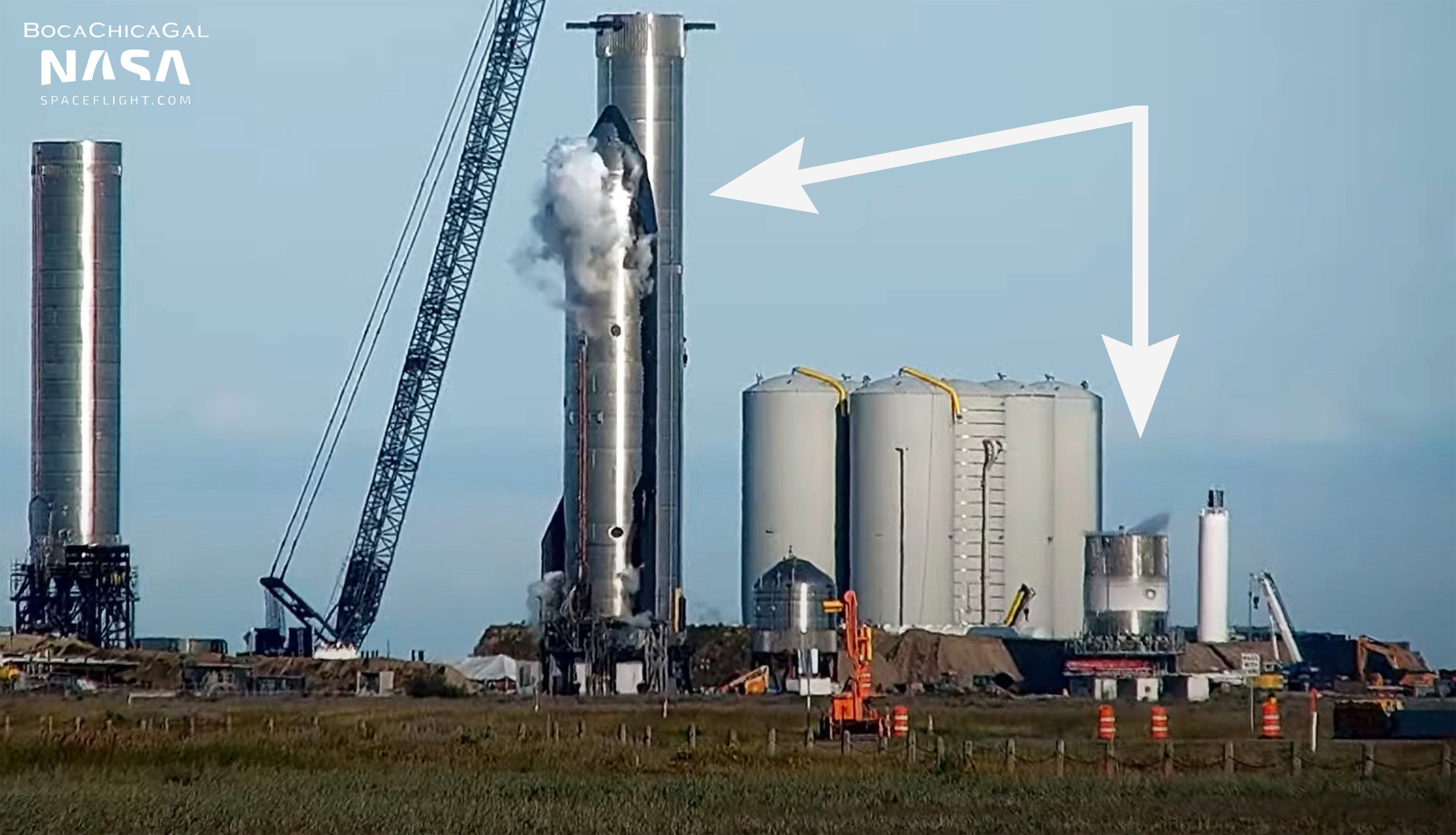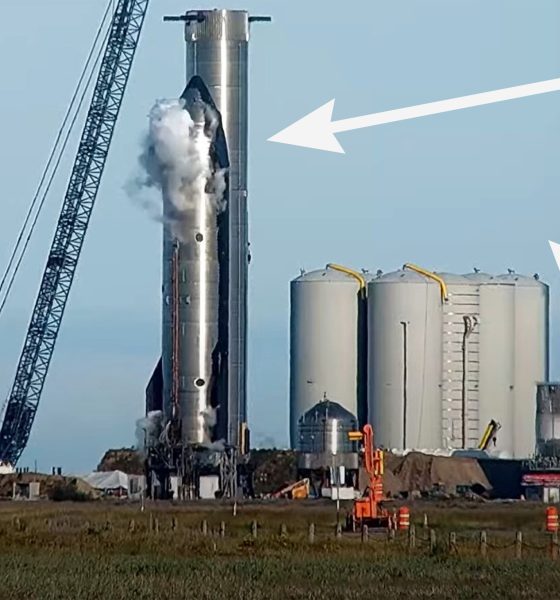

News
SpaceX tests Starship and Frankenstein ‘test tank’ simultaneously
After another few weeks of downtime, SpaceX has simultaneously tested the first orbital-class Starship prototype and a Frankenstein-esque ‘test tank’ at its South Texas facilities. While nothing that occurred was all that visually spectacular, the afternoon of testing was still noteworthy for a couple of reasons.
First up, following a successful six-engine Raptor static fire – the first in Starbase history – on November 12th, all signs pointed to Starship S20 attempting another static fire (its fourth) on December 1st. In the almost three weeks of inactivity between those planned tests, SpaceX likely performed extensive inspections of the pathfinder prototype and its Raptor engines. Technicians also repaired the minor heat shield damage and tile loss that testing incurred and patched a few other ‘holes’, effectively leaving Ship 20 with the first fully finished heat shield by the end of November.
Earlier this week, one of the few remaining Boca Chica Village residents received a safety notice from SpaceX indicating that a static fire test was scheduled on Wednesday, December 1st – followed soon after by a notice to mariners (NOTAM) warning boaters to keep to a safe distance. Two hours into the 10am to 6pm CST test window, Starship S20 was already venting and starting to get frosty, confirming that propellant loading had begun. A little over an hour later, it was clear that SpaceX had aborted the first static fire attempt of the day. For the next three hours, Ship 20 exhibited some unusual behavior including new vents, an apparent header tank pressurization or fill test, and still more odd venting in new places.
In the middle of Starship’s weird nose-related testing, SpaceX began simultaneously loading a new ‘test tank’ known as B2.1 with liquid nitrogen (LN2) – marking the first truly simultaneous test of multiple Starship test articles. As Ship 20 seemingly detanked for the second time that day, the B2.1 tank was fully loaded with LN2 and apparently pressure-tested not long after. A few hours later, the test tank was also detanked and the road to the pad was reopened, marking the end of the day’s testing.
Normally, nothing is particularly unusual or noteworthy about test tank testing. Since January 2020, SpaceX has routinely built and tested tanks that are effectively just shorter versions of actual tanks and hardware, using them to qualify changes to Starship’s design, materials, operations, and more before applying those changes to full-size prototypes. B2.1 is the tenth dedicated test tank to reach the launch pad in a little under two years.
Normally, the ‘B2.1’ name SpaceX has given the tank would imply that it’s a newer booster test tank (using Bx instead of BNx) following in the footsteps of BN2.1, which passed cryogenic and load testing this summer. Instead, though, B2.1 is a bit of a nightmarish amalgamation of seemingly random Starship and Super Heavy parts. Its forward dome is an old, unused booster section complete with the hexagonal structure grid fins would have been brace against. Its aft section is a booster thrust structure. Up to that point, it’s effectively just a copy of BN2.1.
However, SpaceX inexplicably installed a Starship thrust dome inside B2.1’s booster thrust structure, creating a test tank with no obvious relevance to any conceivable Starship or Super Heavy design or prototype. Further, SpaceX rolled B2.1 to the launch site for testing only after installing it on an unused device that’s believed to be the aft half of a dedicated booster structural test stand. In theory, a sort of ‘cap’ would be fitted on top of a booster or test tank installed in the stand’s base and strong cables would connect the two, allowing SpaceX to subject prototypes to compressive stress – like, perhaps, the forces a booster might experience while carrying a fully-fueled 1300-ton Starship to space. The upper half of that test structure has yet to be moved to the launch site.
Altogether, the weird half-complete test stand and bizarre fusion of ship and booster parts make B2.1’s purpose and initial testing a complete mystery. It’s unclear what value it provides that makes it more of a priority than, say, finally starting to test the first flightworthy Super Heavy booster (B4). Ultimately, the most interesting thing about B2.1’s test debut is the fact that it appears to mark the first use of Starbase’s brand new orbital tank farm, which is approaching completion.

Elon Musk
Elon Musk’s X will start using a Tesla-like software update strategy
The initiative seems designed to accelerate updates to the social media platform, while maintaining maximum transparency.

Elon Musk’s social media platform X will adopt a Tesla-esque approach to software updates for its algorithm.
The initiative seems designed to accelerate updates to the social media platform, while maintaining maximum transparency.
X’s updates to its updates
As per Musk in a post on X, the social media company will be making a new algorithm to determine what organic and advertising posts are recommended to users. These updates would then be repeated every four weeks.
“We will make the new 𝕏 algorithm, including all code used to determine what organic and advertising posts are recommended to users, open source in 7 days. This will be repeated every 4 weeks, with comprehensive developer notes, to help you understand what changed,” Musk wrote in his post.
The initiative somewhat mirrors Tesla’s over-the-air update model, where vehicle software is regularly refined and pushed to users with detailed release notes. This should allow users to better understand the details of X’s every update and foster a healthy feedback loop for the social media platform.
xAI and X
X, formerly Twitter, has been acquired by Elon Musk’s artificial intelligence startup, xAI last year. Since then, xAI has seen a rapid rise in valuation. Following the company’s the company’s upsized $20 billion Series E funding round, estimates now suggest that xAI is worth tens about $230 to $235 billion. That’s several times larger than Tesla when Elon Musk received his controversial 2018 CEO Performance Award.
As per xAI, the Series E funding round attracted a diverse group of investors, including Valor Equity Partners, Stepstone Group, Fidelity Management & Research Company, Qatar Investment Authority, MGX, and Baron Capital Group, among others. Strategic partners NVIDIA and Cisco Investments also continued support for building the world’s largest GPU clusters.
News
Tesla FSD Supervised wins MotorTrend’s Best Driver Assistance Award
The decision marks a notable reversal for the publication from prior years, with judges citing major real-world improvements that pushed Tesla’s latest FSD software ahead of every competing ADAS system.

Tesla’s Full Self-Driving (Supervised) system has been named the best driver-assistance technology on the market, earning top honors at the 2026 MotorTrend Best Tech Awards.
The decision marks a notable reversal for the publication from prior years, with judges citing major real-world improvements that pushed Tesla’s latest FSD software ahead of every competing ADAS system. And it wasn’t even close.
MotorTrend reverses course
MotorTrend awarded Tesla FSD (Supervised) its 2026 Best Tech Driver Assistance title after extensive testing of the latest v14 software. The publication acknowledged that it had previously criticized earlier versions of FSD for erratic behavior and near-miss incidents, ultimately favoring rivals such as GM’s Super Cruise in earlier evaluations.
According to MotorTrend, the newest iteration of FSD resolved many of those shortcomings. Testers said v14 showed far smoother behavior in complex urban scenarios, including unprotected left turns, traffic circles, emergency vehicles, and dense city streets. While the system still requires constant driver supervision, judges concluded that no other advanced driver-assistance system currently matches its breadth of capability.
Unlike rival systems that rely on combinations of cameras, radar, lidar, and mapped highways, Tesla’s FSD operates using a camera-only approach and is capable of driving on city streets, rural roads, and freeways. MotorTrend stated that pure utility, the ability to handle nearly all road types, ultimately separated FSD from competitors like Ford BlueCruise, GM Super Cruise, and BMW’s Highway Assistant.
High cost and high capability
MotorTrend also addressed FSD’s pricing, which remains significantly higher than rival systems. Tesla currently charges $8,000 for a one-time purchase or $99 per month for a subscription, compared with far lower upfront and subscription costs from other automakers. The publication noted that the premium is justified given FSD’s unmatched scope and continuous software evolution.
Safety remained a central focus of the evaluation. While testers reported collision-free operation over thousands of miles, they noted ongoing concerns around FSD’s configurable driving modes, including options that allow aggressive driving and speeds beyond posted limits. MotorTrend emphasized that, like all Level 2 systems, FSD still depends on a fully attentive human driver at all times.
Despite those caveats, the publication concluded that Tesla’s rapid software progress fundamentally reshaped the competitive landscape. For drivers seeking the most capable hands-on driver-assistance system available today, MotorTrend concluded Tesla FSD (Supervised) now stands alone at the top.
News
Elon Musk’s Grokipedia surges to 5.6M articles, almost 79% of English Wikipedia
The explosive growth marks a major milestone for the AI-powered online encyclopedia, which was launched by Elon Musk’s xAI just months ago.

Elon Musk’s Grokipedia has grown to an impressive 5,615,201 articles as of today, closing in on 79% of the English Wikipedia’s current total of 7,119,376 articles.
The explosive growth marks a major milestone for the AI-powered online encyclopedia, which was launched by Elon Musk’s xAI just months ago. Needless to say, it would only be a matter of time before Grokipedia exceeds English Wikipedia in sheer volume.
Grokipedia’s rapid growth
xAI’s vision for Grokipedia emphasizes neutrality, while Grok’s reasoning capabilities allow for fast drafting and fact-checking. When Elon Musk announced the initiative in late September 2025, he noted that Grokipedia would be an improvement to Wikipedia because it would be designed to avoid bias.
At the time, Musk noted that Grokipedia “is a necessary step towards the xAI goal of understanding the Universe.”
Grokipedia was launched in late October, and while xAI was careful to list it only as Version 0.1 at the time, the online encyclopedia immediately earned praise. Wikipedia co-founder Larry Sanger highlighted the project’s innovative approach, noting how it leverages AI to fill knowledge gaps and enable rapid updates. Netizens also observed how Grokipedia tends to present articles in a more objective manner compared to Wikipedia, which is edited by humans.
Elon Musk’s ambitious plans
With 5,615,201 total articles, Grokipedia has now grown to almost 79% of English Wikipedia’s article base. This is incredibly quick, though Grokipedia remains text-only for now. xAI, for its part, has now updated the online encyclopedia’s iteration to v0.2.
Elon Musk has shared bold ideas for Grokipedia, including sending a record of the entire knowledge base to space as part of xAI’s mission to preserve and expand human understanding. At some point, Musk stated that Grokipedia will be renamed to Encyclopedia Galactica, and it will be sent to the cosmos.
“When Grokipedia is good enough (long way to go), we will change the name to Encyclopedia Galactica. It will be an open source distillation of all knowledge, including audio, images and video. Join xAI to help build the sci-fi version of the Library of Alexandria!” Musk wrote, adding in a later post that “Copies will be etched in stone and sent to the Moon, Mars and beyond. This time, it will not be lost.”








